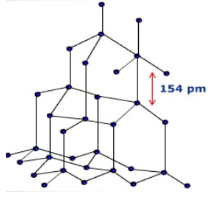(1) Silicates is the general term applied for the
solids with silicon – oxygen bonds.
(2) Silicates are regarded as the salts of silicic acid, H4SiO4. All the
silicates are comprised of SiO4
units.
(3) The Silicates units have a tetrahedral structure
formed as a result of sp3 hybridization. Silicon atom has its complete octet
but each oxygen atom is still short of one electron to complete its octet. They
can complete their octet by taking up 4 electrons from a metal, getting
converted to an anion [SiO4]-4
(4) All the solids Silicates contain silicate ion (SiO4)4- as the basic structural unit.
(5)The silicate ion is tetrahedral in structure and
when the one or more oxygen atoms between such tetrahedrons, a complex
structure arise.
(6) All the silicates units are non planer
(7) The Si atom in Silicates unit is covalently
bonded to 4 oxygen atoms. Each oxygen atom
possesses a formal negative charge. Hence each tetrahedral unit has a formal
charge of –4. When linked together, the extended
units are also negatively charged. Presence of other metallic ions such as Ca2+or Mg2+
are necessary for electrical neutrality.
(8) The covalent Si-O
bond, having a bond enthalpy of 466 kJ mol-1 is particularly strong compared
with the C-C bond which has a bond enthalpy of
347 kJ mol-1. The linkage -Si-O-Si-O-
is very stable and instead of existing as discrete units of (SiO4)4- ions, the silicates tend to
form chains, sheets or networks.
CLASSIFACATION OF SILICATES:
The silicates may be classified in to following
groups chain silicates, ring silicates, cyclic silicates, sheet silicates,
three – dimensional silicates depends on the way in which the (SiO4)4- tetrahedral units are linked together.
(1) Ortho silicates or Neso Silicates (SiO4)4-:
Number of oxygen shared by tetrahedron is Zero(0).Orthosilicates are salts of orthisilicic acid
Example; Zircon ( ZrSiO4 ), Phenacite (Be2SiO4)
, Willemite (Zn2SiO4),
(2) Pyro silicates or Sorosilicates or Disisilicates (Si2O7-6) :
(1) Number of oxygen atoms shared per tetrahedron is 1(one).
(2)Total number of shared oxygen towards one Si atom is ½
(3)Total contribution of all oxygen towards one Si atom is 3.5
(4) In pyrosilicates, one tetrahedron shares its one oxygen atom
with other tetrahedron on they are salts of pyrosilicic acids .
Example: Thortveitite (Se2Si2O7);
lanthanoids disilicates (Ln2[Si2O7]
and Hemimorphite Zn4 (OH)2[Si2O7].
(3) Meta silicates:
(A) Linear chain Meta Silicates [(SiO3)n -2n ] :
In chain silicates each tetrahedron shares its two
oxygen atoms with other tetrahedron atom such that a linear endless chain of
silicates is formed , however in terminating chain silicates (n)
tetrahedron shares one oxygen.
Example: Spodumene (LiAlSiO3)2
; Wollastonite [Ca3(SiO3)3] Enstatite [Mg2SiO3)3]
and Diopsite [ CaMg(SiO3)2]
(B) Cyclic meta silicates [(SinO3n)
-2n ] :
(1) Number of oxygen atoms shared per tetrahedron is 2(Two).
(2) Total number of shared oxygen towards one Si atom is one
(1)
(3) In cyclic silicates each tetrahedron shares its two oxygen
atoms with other tetrahedron atom such that a cyclo silicates is formed.
(4) There are several cyclo
silicate is known like n= 3, 4, 5 ,6 but
3 and 6 is most common.
Example:
Wollasponite [ Ca3(Si3O9)]
, Benitoite [BaTi(Si3O9)] , Beryl
[Be3Al2(Si3O9)2]
(4) Double chain Silicates or Amphiboles (Si4O11)-6n :
(1) Number of Silicon atoms in basic units is 2 .
(2) Total number of oxygen atoms in basic unit is 5.5.
(3) Number of oxygen atoms shared per tetrahedron is 3+2/2=2.5
(4) In this type silicates two strands of chain silicates are
linked to each other by sharing oxygen atoms, Amphiboles are an asbestos
mineral which contains magnesium.
(5) General
formula of double chain silicates (Si4O11)-6n
Example:
Tremotites [Ca2Mg5(Si4O11)2(OH)2]
Crocidolite [Na2Fe3Fe2(Si4O11)2(OH)2]
(5) Sheet Silicates or phyllo silicates [(Si2O5)n]-2n:
In Sheet Silicates, one tetrahedron shares its three (3)
oxygen atom such that a two dimensional non
planer layer is formed , such type of silicates have greasy touch or
lubricating action.
Example: Clay [Al2(Si2O5)(OH)4
,Talc or Soap Stone [Mg3(Si2O5)2(OH)2 ,
Kaolinite [Al2(Si2O5)(OH)4 Chrysotite (white Asbestos) [Mg(Si2O5)(OH)4
(6) 3D-Silicates:
Examples:
Silica, Quarts, feldspar, Zeolite, Ultramarine
Related Questions:


















